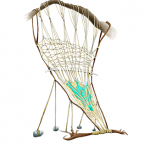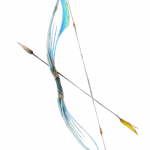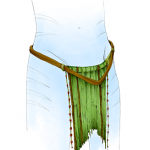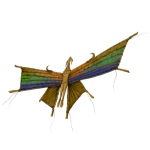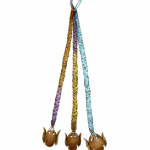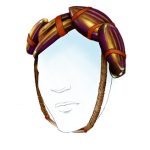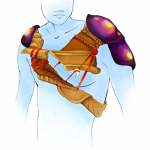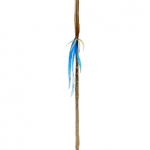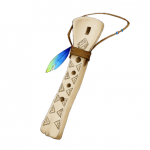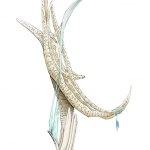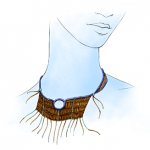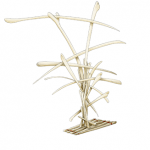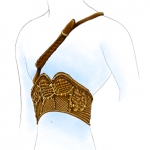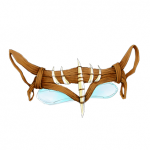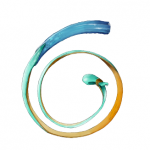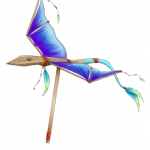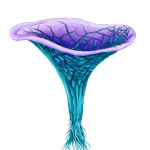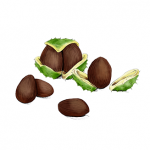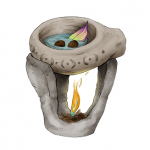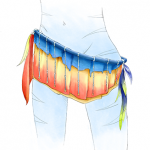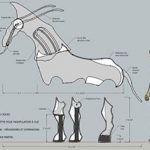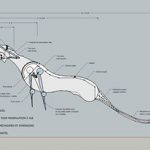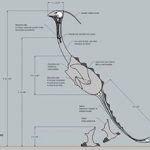Earlier in the month Cirque du Soleil invited us to explore the distant planet of Pandora (in similar vain to Google’s Sensory Chrome Experiment: “Movi Kanti Revo”) to unearth artifacts to piece together the identities of five ancient clans. The more artifacts you found, the more information you unlocked, and the closer you got to winning a one-of-a-kind experience with three of your closest friends. In order to unlock the sweepstakes you had to collect at least 12 of these artifacts (but they were easy to spot), but we didn’t stop exploring once we did so. There were 25 total artifacts to find in the jungles of Pandora, five for each clan, and in doing so we learned quite a bit about those clans, and what possibly to expect from “TORUK – The First Flight” itself!
So, here’s what we’ve learned:
CLAN OMATICAYA
OMATICAYA SYMBOL
Deep in the heart of the jungle, in the alcoves and hollows of a soaring Hometree, is the habitat of the highly spiritual Omaticaya clan. The Hometree is an individual tree that grows as a mighty structure. For the Omaticaya clan, their home is an ever-present symbol of the strength in community. The Omaticaya are also renowned for their stunning textiles and weaving capabilities. Their intricate patterns create some of the most sophisticated fabrics and structures in all the land. The unbreakable focus and dexterity of the Omaticaya at the loom makes this one of the most mesmerizing sights to be seen on Pandora.
MOTHER LOOM
Perhaps the most significant piece of Omaticaya culture is the Mother Loom. It stands in a place of honor inside the Omaticaya home, appropriately called the Hometree. For the Omaticaya, time at the loom is just as much about the practice of craft as it is about producing selfless joy. Each textile is the output of pure enjoyment and happiness. This energy is weaved into each brilliant piece and can create a serene force field of euphoria-like energy.
CEREMONIAL BOW
There are many bows a Na’vi of any clan may fashion or acquire. from a young child to a sage elder. The most basic is a child’s bow often adorned by hand with twine and other decorative elements. While a children’s bow is nothing particularly inventive in terms of design, it can still be lethal if an arrow is shot with cunning accuracy. When a Na’vi youth reaches a certain point in adolescence, they carve a bow from the Hometree. This represents a coming-of-age ritual. At this point, the bow is called “The Hunting Bow”, appropriately named for the task it often carries out. One of the most prestigious bows is the Ceremonial Bow, often used by clan elders for various ceremonies. One’s path to earning a Ceremonial Bow requires patience as it is traditionally passed down through generations. A Ceremonial Bow is carved from the Hometree and is a beautiful representation of the peak of Na’vi design. Its curved shape honours the Direhorse, a six-legged creature native to Pandora, known to help the Na’vi during hunt or battle.
LOINCLOTH
The Omaticaya take a more simplified approach to dress than other clans and typically bare more skin. This giving of flesh symbolizes their open, pure, and giving spirit towards Eywa. A main piece of dress is the tweng (loincloth). It helps distinguish the various families within the greater Omaticaya clan. Members of the same kin wear specific color combinations, woven patterns, and decorative accents with pride, some of which can be traced back to ancient ancestors.
LEONOPTERYX TALISMAN
This beautiful Omaticayan toy is crafted from flexible sticks and decorated with twigs and reeds to resemble the Great Leonopteryx. The Leonopteryx is also known in Na’vi as the Toruk, which roughly translates as “the last shadow”. When stalking a prey, the Toruk casts a massive shadow that blankets the landscape.The leonopteryx shadow may well be the last shadow you will ever see.
CLAN TIPANI
TIPANI SYMBOL
Fierce warriors. Virtuous fighters. Naturally skilled hunters. The Tipani rely heavily on their keen senses and predatory instincts for survival. During their adolescent years, strict focus is set on developing both the mind and body for battle under the guidance of the clan elders. The Tipani are the only Na’vi clan known to wear armour. Their statuesque presence, brute strength, astute sense of hearing, and sharp eyesight enable the Tipani to walk the land without fear. Sure and light-footed, a Tipani goes easily undetected. The most experienced Tipani warrior can stock their prey with such precision that the hunted scarcely realizes its danger until only moments before its unfortunate demise.
BOLA
The bola is mainly a hunting weapon that requires a bit of choreography. One must twirl the bola high in the air, then with great might, fling the weighted rope with exact accuracy. When the target is hit, the strands are wrapped around the animal and used as a method of restraint. There is no intent to make the animal suffer with the bola. It is a non-harmful form of hunting to respect Eywa’s creatures. Moments before taking the animal’s life, the hunter kneels beside the creature to place a calming hand on its chest. A transfer of spiritual energy occurs between hunter and prey, ensuring a tranquil passing into the afterlife.
HELMET
Many Tipani apprentices wear a special helmet, which is essentially a long strand of leather wrapped around animal or insect shells to hold them in place. These protective bonnets are used during preliminary training apprentices must face without the aid on an elder. While the Na’vi do not fear, wise elder ask the young to wear helmet when attempting difficult manoeuvres. Most obviously, their function is a form of protection, but the helmet also trains clarity and confidence of mind. The spirits of long-lost animals whisper through the shell into the psyche of the warrior in training to empower moves while creating an inner sense of calm.
ARMOR
Many clans have a hand in fashioning armor but the Tipani are the only ones to wear these protective pieces regularly. In fact, there is a wardrobe of various armors for specific purposes such as hunting, training and battle, and less aggressively, singing and dancing. The armor is mostly made of bones, shells, plants, insects and even claws of deceased animals. The Tipani believe the animals’ predatory and survival instincts are transferred to the warrior who wears the armor.
WOODEN SPEAR
The wooden spear is one of the earliest examples of weaponry ever recorded on Pandora. All clans use wooden spears, but the Tipani are masters of its deadly purpose. It is not within the Tipani to engage in senseless combat. When they must fight, they are very mindful of their choice of weapon. Preference for the spear is based on versatility. A knife is a magnificent close quarters weapon and a bow is unmatched in its range advantages. A spear’s short-range and long-range proficiency affords dominance on the battleground regardless of enemy. Historically speaking, the wooden spear is the first weapon a young Tipani hunter trains with. A centuries-old tradition sees clan elders accompany groups of warrior apprentices into the woods where athleticism and tranquility are put to the test. Success is not measured by the ability to slay a creature, for many come home empty-handed. It is measured by the ability to stalk prey without making one’s presence known. A master warrior must first acquire the art of light-footedness before training in the art of the kill. As the young Tipani develop into expert warriors, they learn to master many different weapons. The bond they form with their first spear is carried throughout life.
CLAN ANURAI
ANURAI SYMBOL
Meticulous artisans who spare no detail in their craft, the Anurai are a highly resourceful clan of creators who draw on the materials around them. A masterful balance of spirit and ingenuity has set them apart as the finest craftsmen among the Pandoran clans. Wild imagination and visionary prowess guide them to scavenge the vast, bone-littered land in which they live. Both playful and musical, they specialize in fashioning instruments from the ancient bones of animals long laid to rest; skeletal remains of a Thanator, Pandora’s deadliest creature, are the most coveted. Using these and whatever other materials they may find, the Anurai continuously invent and create beautiful objects.
MUSICAL BONE
In addition to sculpture, music is another art form the Anurai explore with animal bones. The animal’s spirit infiltrates the clan members’ body like a forceful muse to guide every cut of the blade. During this process, the artists’ movements are almost instinctual. The animal’s spirit takes over and vanishes in an instant when the instrument is complete. This is a very exciting moment when the Anurai discover the instrument’s sound for the first time. The sound is said to be an expression of gratitude from the animal to the creator. It is an expression of thanks for creating a piece of art that allows their voice to live on. Little is known about this particular flute, but it is said a Na’vi could use this particular musical bone to call upon the Great Leonopteryx.
BONE SCULPTURE
This bone sculpture is a prime example of Anurai artistry and painstaking attention to craft. As an artistic medium, bones are both practical and metaphorical. The Anurai live in a sanctuary littered with bones of ancient animals. This environment fosters an attitude of genuine respect for all life, even after death. Since the dawn of time, the Anurai have carried this belief. Value of life, even in passing, is the main motivation to transform symbols of loss into beautiful works of art. It is believed that this ritual was first inspired by a call from Eywa. The deity led young clan members across a bone-littered desert. Sorrow grew with each repetitive step, passing bone after bone. As they marched into nightfall, at peak of Pandora’s bioluminescence, the clan members were suddenly one with the long-lost creatures. In this moment, these passed spirits felt incredibly alive. The need to celebrate these spirits consumed the clan to the point of epiphany. The Anurai continue to craft impeccable art with the purpose of transforming lost life into eternal treasure.
ANURAI NECKLACE
A symbol of true friendship, this fkxile (bib necklace) is hand woven as tightly as the bond of platonic adoration it represents. The necklace maker is also the gift giver. Each necklace begins its journey around the neck of the friend who made it. Giving the necklace to another is a ritual of devotion whereby two members stand face-to-face with their foreheads pressed together. The necklace is then slid up over one’s head and carefully transferred around the neck of its new owner. The necklace may be passed on from one member to the next, representing an endless line of interconnectivity within the clan.
THANATOR TOTEM
Constructing a Thanator Totem is a balance-testing ritual that relies on the complete sync of two or more clan mates. This harmony is something only true teamwork can provide. Bones are strategically stacked as a fellow clan mate maintains footing. It is impossible to create this totem alone. A single misstep can send bones cascading with great force. The totem honors the mighty Thanator, Pandora’s deadliest creature, to teach the importance of unity, trust, and team work. It reminds the Anurai to react to each other’s actions with empathy and purpose. With a spirit of togetherness, there is hope to champion all of life’s dangers.
CLAN KEKUNAN
KEKUNAN SYMBOL
The Kekunan clan are the most skilled mountain banshee (aka ‘ikran’) riders of all the clans. Lightning fast reflexes, cool composure and a courageous heart help them command the magnificent aerial predators. The Kekunan dress in bright, boisterous colors, a symbol of their unbreakable confidence and a tribute to the creatures that surround and sustain them.
KEKUNAN BATTLE BAND
Vibrant and copper-colored. Durable yet soft to the touch. Woven with flecks of gold string to reflect the sun. This aesthetically intricate piece of dress is reserved for riding a Banshee in a great battle or special ceremony. The beauty of this piece represents members’ sense of pride in their ability to confidently ride a Banshee, particularly in battle. Do not mistake this unabashed confidence for ego. It is a result of achievement, training through insurmountable pain, and fierce determination where anything is possible. This sentiment is expressed through an ancient Na’vi saying, handed down throughout generations: “Nurture physically and spiritually with a forever hunger that may one day feed the greater good of all. Eywa believes in us and with Eywa there is unbreakable belief is oneself.” It is believed that Eywa will watch over the Kekunan who wear the band as they soar through the sky.
RIDER’S MASK
Worn by the brave Mountain Banshee riders of the Kekunan clan, this protective mask shields their eyes from vicious winds. A Mountain Banshee can reach incredible speeds, particularly while diving towards a target. The lens is made from a Plexiglas-like material, naturally created by a neighbouring clan of chemists, the Tawkami. The material is carefully cut and shaped by clan elders who custom-fit each rider. No two masks are alike. Young clan members spend a consistent sixteen hours polishing the lens to translucent perfection. It is a laborious task and a lesson in patience and focus. Once finished, the mask is awarded the riders who successfully complete a rite of passage.
BANSHEE CATCHER
A tool of great significance that is essentially a type of lasso. It is fashioned from the highly durable leaves of the Razor Palm Tree and weighted at one end by stones. Mastering the art of the banshee catcher has become an indispensable skill. The banshee catcher is also an integral piece of a highly dangerous rite of passage where a life-long bond is formed with a Mountain Banshee. This creature is an airborne predator that lives in Pandora’s mountainous territory. The banshee catcher was invented by Taronyu, an Kekunan clan legend. He was the first to successfully form a bond with a wild Mountain Banshee he named Rotalyu. Each day, Taronyu would look to the sky to admire the soaring beasts. A deep desire to someday fly among them stewed inside him. With each tremendous flap of the wing, Taronyu was drawn to the graceful creature. He believed someday the Mountain Banshee and Na’vi would move through the sky as one. And he wanted to be the first to do it. How to catch the wild creature was the challenge. Taronyu went to work. Braiding durable leaves to form a tightly wound rope, he fashioned a lasso to secure the beast’s neck. Three long strands weighted by rocks would knock the beast on its head with no long-lasting harm. Climbing high into the mountains, Taronyu relentlessly studied one specific banshee for eight days. On the eighth day, with four flicks of the lasso, the banshee catcher caught the snout and soon the beast fell calm. Taronyu triumphantly returned to his clan on the back of Rotalyu and earned the title of Ikran Makto (Banshee Rider).
KEKUNAN TOY
Ikran Makto (aka Banshee Rider) training begins at a very early age. In the eyes of a Na’vi child an ikran toy feels like a real banshee. Clan elders use the ikran toy as an education tool to demonstrate the dynamics and physics of flight. Clan youth are taught specific manoeuvres that mirror the behaviors of real mountain banshees, such as diving, gliding, and turning. This develops concentration and quick reflexes – two indispensible traits of highly skilled banshee riders. The rider cannot choose any banshee. Beast and Na’vi mutually choose each other and enter a symbiotic relation for their entire life.
CLAN TAWKAMI
TAWKAMI SYMBOL
An unrelenting curiosity, combined with a persistent quest for knowledge of the natural world, marks the Tawkami as proficient gifted. Their deep botanical knowledge allows them to create a vast array of potions and extract essences from any natural material. From a single seed, they may gain power over other creatures and manipulate the world around them with an expertise that provides great advantage over predators. A Tawkami’s mission is to sustain the sacred nature of Pandora’s beautiful ecosystem. Many clan members take shelter inside massive, bioluminescent flowers from which they draw great spiritual wisdom.
HEALING ROSE
The Healing Rose is a gigantic plant found predominantly in wooded areas. It has a similar shape and size to the poisonous and deadly Pseudocenia rosea,to the exception of the petal that looks like a hook on the latesté. Measuring nearly six meters tall, it produces nectar with various regeneration and healing powers, both spiritual and physical. This particular plant plays a large role in the lives of the Tawkami. This clan of spiritual alchemists draws higher-power wisdom from inside the Sílronzem Rosea. They climb inside the plant to practice a form of meditation that can last up to four full days. What is now considered to be a sacred Tawkami ritual was actually born from an accidental discovery. The story begins when an unfortunate pair of Tawkami crossed paths with a hungry pack of viperwolves. A viperwolf is a powerful, six-legged beast that travels swiftly over long distances in search of prey. The Tawkami clan mates fell wounded by the razor-sharp teeth of the ferocious viperwolves. They ran furiously and came upon a field of large, pitcher-shaped plants. In a moment of pure desperation, the duo climbed inside to hide. The viperwolves miraculously lost track of their scent and gave up the hunt. As the clan mates climbed out of the enormous plants, they were astonished. Their wounds were healed. From that day forth, this healing flower has been used to create various soothing potions and cures.
TRANQUIL SEED
A complex combination of various leaves, roots, and pollens are mashed into a thick syrupy substance to extract psychoactive chemicals. Over time, these chemicals bond together to form little kernels called the Tranquil Seed. The Tawkami break open these kernels to release a tranquilizing smoke that can be used to tame wild animals. The Tawkami track and store the Tranquil Seed’s precise formula in their mind with no tangible record. Where most see a beautiful landscape, the Tawkami see Pandora as an elaborate recipe.
EXTRACTOR
This device is used to harvest essential oils from flora to create various elixirs, pastes and potions. Effective use of an extractor relies on three main parts: a stone bowl, a flame and special extraction seeds. The extraction process is quite simple. First, the desired flora is placed in the stone bowl with the seeds. Water is then added and a soft flame is lit under the bowl. As the water reaches a gentle boil, the seeds release nutrients and absorb the flora’s essential oils. When all water evaporates extraction is complete.
SASH
As the Tawkami train to master the arts of botany and alchemy, srä (sash) are awarded to celebrate ongoing studies and indicate level of competence. The more colorful the srä, the more experienced the alchemist. At the start of training, all apprentices are given a basic srä to wear around their waist. The first lesson is identification. There are thousands of plants, herbs, and seeds native to Pandora. Once identification is mastered, education moves on to learning various formulas for potions. With every level reached, a different colored strip of fabric is added to the srä.
INSIDE THE CREATORS STUDIO
And check out this inside peek into the creative side of TORUK – The First Flight!
Sketch of the Direhorse – Lived-in puppet
THE DIREHORSE BONDS WITH A RIDER THROUGH ONE OF ITS ANTENNAE
Swift and nimble, the six-legged Direhorse is a calm, highly intelligent animal. Two puppeteers work in unison inside the structure. The first controls the front part, including neck and head; his legs become the creature’s two front legs. The second puppeteer controls the middle legs with his hands and the animal’s waist with his wrist; his legs become the animal’s hind legs. The puppeteers stand on platform shoes to better convey the creature’s impressive size.
Sketch of the Turtapede – Lived-in puppet
A TURTLE AND A STARFISH FOLDED INTO ONE
With its large dorsal fin and long tail, the Turtapede is agile under water. The sea-dwelling creature is controlled from the inside by a puppeteer stretched out on a wheeled platform similar to a mechanic’s. The puppeteer uses his arms to move the creature’s head and arms, controlling the feet with his legs. When the Turtapede emerges from the water, mesmerizing colors start to shimmer in the translucent area on its shell.
Sketch of the Viperwolf – In-view puppet
BEWARE THE VIPERWOLF!
With its low-slung head and snakelike jaw, the six-legged viperwolf is a swift, fiercely intelligent animal that hunts in packs. The puppeteer uses his hands to control the upper body and articulated head of the viperwolf, working each of the four front legs with his fingers. The puppeteer’s legs become the animal’s hind legs. The viperwolf puppet has green luminous eyes, is illuminated from the inside, and glows red and blue.
Sketch of the Austrapede – Lived-in puppet
A CROSS BETWEEN AN OSTRICH, A PINK FLAMINGO AND A DINOSAUR
With its flat, broad beak and long neck and tail, the gentle Austrapede is a relatively small bird by Pandoran standards. A single puppeteer housed inside controls the neck and head with one hand, using his other hand to work the wings, which start flapping whenever the Austrapede is frightened. Perched on 30-cm-high platform shoes that give the animal its distinct hop, the puppeteer can see through the animal’s gills, which are a common feature of Pandoran fauna.
# # #
Puppet designer Patrick Martel talks about his craft and the magical puppetry
SUSPENDING DISBELIEF THROUGH PUPPETRY
Puppet Designer Patrick Martel conveys his passion for turning inanimate objects into living things, and talks about some of the astonishing creatures he is designing for the show. Whether he’s creating a pack of viperwolves or a great leonopteryx, his goal is always to urge the spectator to suspend disbelief for a moment – to create the illusion that these are not mere machines made of metal and cloth, but living beings from a faraway planet.
# # #
Inspired by James Cameron’s AVATAR, TORUK – The First Flight, a live experience by Cirque du Soleil, envisions a world beyond imagination thousands of years before the events depicted in the film.
Discover what TORUK – The First Flight is all about at Cirque du Soleil’s website: https://www.cirquedusoleil.com/toruk/
And you can still enter the world of Pandora here:
https://www.cirquedusoleil.com/toruk/experience
